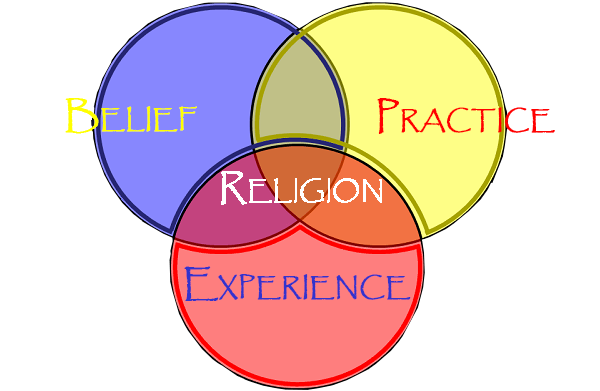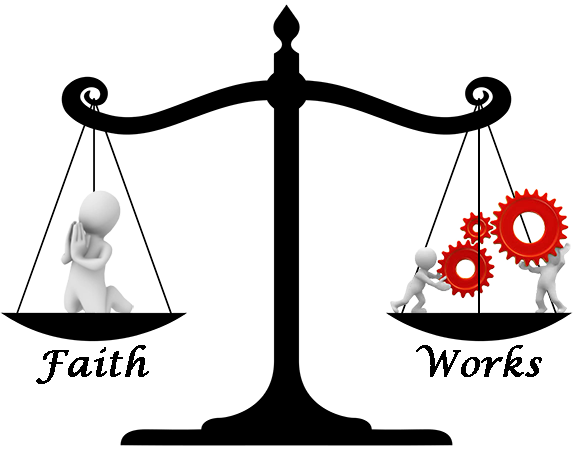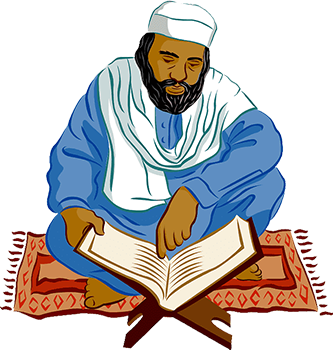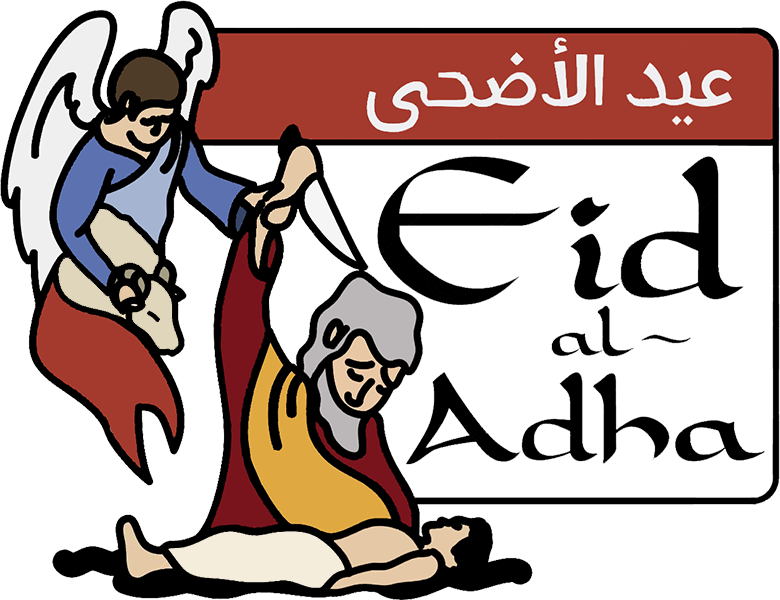
 | While the first of the Five Pillars is a “profession
of faith,” the remaining Pillars focus on concrete actions that all
Muslims are required to perform (insofar as they are able). In order to
highlight this close relationship between “faith” and “works” in Islam, I have therefore included a discussion of shari’ah
(law) in the following section. As we go through the material on each
of the Five Pillars, you should think about the particular ways that
“belief,” “practice” and “experience” intersect in the Islamic
tradition (i.e., does Islam give equal weight to belief, practice, and
experience, or is one valued more than the others). |

 The shari’ah is based chiefly on the Qur’an and
Sunnah of Muhammad, who was the first to apply the generalizations of the
Qur’an to specific life situations. ... Shari’ah
pertains to many areas of life. For example, it specifies patterns for
worship (instructions pertaining to the Five Pillars of Islam) as well
as detailed prescriptions for social conduct, to bring remembrance of God into every aspect of daily life and practical ethics into the fabric of society. These prescriptions include injunctions against
drinking
intoxicating beverages; eating certain meats; gambling
and vain sports; sexual relations outside of marriage; and sexually
provocative
dress, talk, or actions. They also include positive measures,
commanding justice, kindness, and charity. The shari’ah is based chiefly on the Qur’an and
Sunnah of Muhammad, who was the first to apply the generalizations of the
Qur’an to specific life situations. ... Shari’ah
pertains to many areas of life. For example, it specifies patterns for
worship (instructions pertaining to the Five Pillars of Islam) as well
as detailed prescriptions for social conduct, to bring remembrance of God into every aspect of daily life and practical ethics into the fabric of society. These prescriptions include injunctions against
drinking
intoxicating beverages; eating certain meats; gambling
and vain sports; sexual relations outside of marriage; and sexually
provocative
dress, talk, or actions. They also include positive measures,
commanding justice, kindness, and charity.  Women are given many legal
rights, including the right to own property, to divorce (according to
certain schools of law), to inherit, and to make a will. These rights,
divinely decreed during the time of the Prophet, 1,400 years ago, were
not available to women in the West until the nineteenth
century. ... Different schools of fiqh (jurisprudence) developed as Islam spread beyond Arabia. Within Sunni Islam, there are four major schools of fiqh, and there are several Shi’a
schools. The schools, which developed in different geographical
regions, have different views on how best to exercise reason and
analogy in reaching legal decisions, particularly when a specific issue is not addressed within the Qur’an or Sunnah. Thus in actual practice there may be multiple legal opinions on a particular question, although
contemporary media accounts of shari’ah in the West may portray it as monolithic and unchanging. ... Careful study of the Qur’an and Sunnah as the basis
for legal opinions is undertaken by the ulama, scholars who devote their
lifetimes to developing this knowledge. (Living Religions, 397-8) Women are given many legal
rights, including the right to own property, to divorce (according to
certain schools of law), to inherit, and to make a will. These rights,
divinely decreed during the time of the Prophet, 1,400 years ago, were
not available to women in the West until the nineteenth
century. ... Different schools of fiqh (jurisprudence) developed as Islam spread beyond Arabia. Within Sunni Islam, there are four major schools of fiqh, and there are several Shi’a
schools. The schools, which developed in different geographical
regions, have different views on how best to exercise reason and
analogy in reaching legal decisions, particularly when a specific issue is not addressed within the Qur’an or Sunnah. Thus in actual practice there may be multiple legal opinions on a particular question, although
contemporary media accounts of shari’ah in the West may portray it as monolithic and unchanging. ... Careful study of the Qur’an and Sunnah as the basis
for legal opinions is undertaken by the ulama, scholars who devote their
lifetimes to developing this knowledge. (Living Religions, 397-8)
What is the
relationship
between "faith" and "works" in Islam?

Do
you
think that Islam is closer to Judaism or Christianity in this regard?
|

Five times a day, the faithful are to perform
ritual ablutions with water (or sand or earth if there is no water), face in the direction of Mecca, and recite a
series of prayers and passages from the Qur’an, bowing and kneeling. Around the
world, this communal facing of Mecca
for prayer unites all Muslims into a single world family. When the
prayers are recited by a congregation, all stand and bow shoulder to
shoulder, with no social distinctions. In a mosque, women and men
usually pray separately, with the women in rows behind the men, or in a
separate area. There may be an imam,
or prayer leader, but no priest stands between the worshiper and God.
On Friday noon, there is usually a special prayer service in the
mosque. Remembrance of God is an everyday obligation. (Living Religions, 387-9)
Before Salaat:
Body, clothes and place of prayer must be clean.
Perform wudu (ritual ablution) if needed.
Traditionally, women cover their hair.
Face the Qibla, the direction of Mecca.
Stand erect, head down, hands at sides, feet evenly spaced.
Recite Iqama (private call to prayer):
God is the most great. (4x)
I bear witness that there are no gods but God. (2x)
I bear witness that Muhammad is the Messenger of God. (2x)
Come to prayer. (2x)
Come to felicity (i.e. salvation) (2x)
[Prayer is better than sleep.] (2x; morning only)
Our prayers are now ready. (2x)
God is the most great. (2x)
There is no deity save God. (1x)
|
What are the similarities and/or differences between this form of
prayer
and any other forms of prayer with which you are familiar (if
any)?
|

The Qur’an links prayer with zakat, charity or almsgiving, the third pillar. One’s prayer is accepted only if one also shares with others. Accordingly, at
the end of the year, all Muslims must donate
at least two and a half percent of their accumulated wealth to needy
Muslims.
This provision is designed to help decrease inequalities in wealth and
to
prevent personal greed. ... Many stories from the life of the Prophet
Muhammad teach that one should help others whether or not they are
Muslims. For example, the Prophet’s
neighbor was a non-Muslim. The Prophet reportedly gave him a gift every
day, even though the neighbor daily left garbage at his door. Once the neighbor was sick, and the Prophet visited him. The neighbor asked, “who are you to help me?” The Prophet replied, “You are my brother. I must help you.” (Living Religions, 390)
How might the practice of giving charity contribute to one's spiritual
development?
|

Frequent fasts are recommended to Muslims, but the only one
that is obligatory is the fast during Ramadan,
commemorating the first
revelations of the Qur’an to Muhammad. For all who are beyond puberty,
but not
infirm, sick, menstruating, or nursing children, a dawn-to-sunset
abstention
from food, drink, sexual intercourse, and smoking is required for the
whole
month of Ramadan. The fasting also extends to abstaining from negative
emotions such as anger. … Many people indeed feel that they are
spiritually more sensitive and
physically more healthy during Ramadan fasting. Fasting liberates a
person’s body from the heaviness
of food and it is also a lesson for the soul, teaching it not to allow
anything
into the mind and heart that would distract one from God. It is
believed that
control of the body’s desires also builds the patience and mastery
needed to control the
lower emotions, such as anger and jealousy. (Living Religions, 390-2)
What is the religious significance of fasting?
|
All
Muslims who are physically and financially able to do so are expected
to make the pilgrimage at least once in their lifetime. It involves a
series of symbolic rituals designed to bring the faithful as close as
possible to God. Male pilgrims wrap themselves in a special garment of
unsewn cloths, rendering them all alike, with no class distinctions.
The garment is like a burial shroud, for by dying to their earthly life
they can devote all their attention to God. Women who perform hajj are
not required to wear unsewn cloth, but their dress should be modest.
For all pilgrims, it is a time for dhikr, the constant repetition of the Shahadah, the remembrance that there is no god but God. (Living Religions, 392)

Mina
After the morning prayer on the 8th of Dhu al-Hijjah, the pilgrims proceed to Mina where they spend the whole day and offer noon, afternoon, evening, and night prayers. The next morning after morning prayer, they leave Mina to go to Arafat. (Hajj#First_day)  Mount Arafat
Mount Arafat
On 9th Dhu al-Hijjah before noon, pilgrims arrive at Arafat,
a barren and plain land some 20 kilometers east of Mecca, where they
stand in contemplative vigil: they offer supplications, repent on and
atone for their past sins, and seek mercy of God, and listen to sermon
from the Islamic scholars who deliver it from near Jabal al-Rahmah (The
Mount of Mercy) from where Muhammad is said to have delivered his last sermon.
Lasting from noon through sunset, this is known as ’standing before
God’ (wuquf), one of the most significant rites of Hajj. At Masjid
al-Namirah, pilgrims offer noon and afternoon prayers together at noon time. A pilgrim’s Hajj is considered invalid if they do not spend the afternoon on Arafat. (Hajj#Second_day)
 Muzdalifah
Muzdalifah
Pilgrims must leave Arafat for Muzdalifah after sunset without praying maghrib (evening) prayer at Arafat.
Muzdalifah is an area between Arafat and Mina. Upon reaching there,
pilgrims perform Maghrib and Isha prayer jointly, spend the night
praying and sleeping on the ground with open sky, and gather pebbles for
the next day’s ritual of the stoning of the Devil (Shaitan). (Hajj#Second_day)
Mina
One
of the main trials of Abraham’s life was to face the command of God to
sacrifice his dearest possession, his son. The son is not named in the
Quran, but Muslims believe it to be Ishmael, though it is mentioned as
Isaac in the Bible. Upon hearing this command, Abraham prepared to
submit to will of God. During this preparation, Shaitan (the Devil)
tempted Abraham and his family by trying to dissuade them from carrying
out God’s commandment, and Abraham drove Satan away by throwing pebbles
at him. In commemoration of their rejection of Satan, stones are thrown
at symbolic pillars during the Stoning of the Devil during Hajj rites. (Eid_al-Adha)

After the casting of stones, animals are slaughtered to
commemorate the story of Abraham and Ishmael. Traditionally the pilgrims
slaughtered the animal themselves, or oversaw the slaughtering. Today
many pilgrims buy a sacrifice voucher in Mecca before the greater Hajj
begins, which allows an animal to be slaughtered in the name of God
(Allah) on the 10th, without the pilgrim being physically present.
Modern abattoirs complete the processing of the meat, which is then
sent as charity to poor people around the world. (Hajj#Third_day)
 |

|



